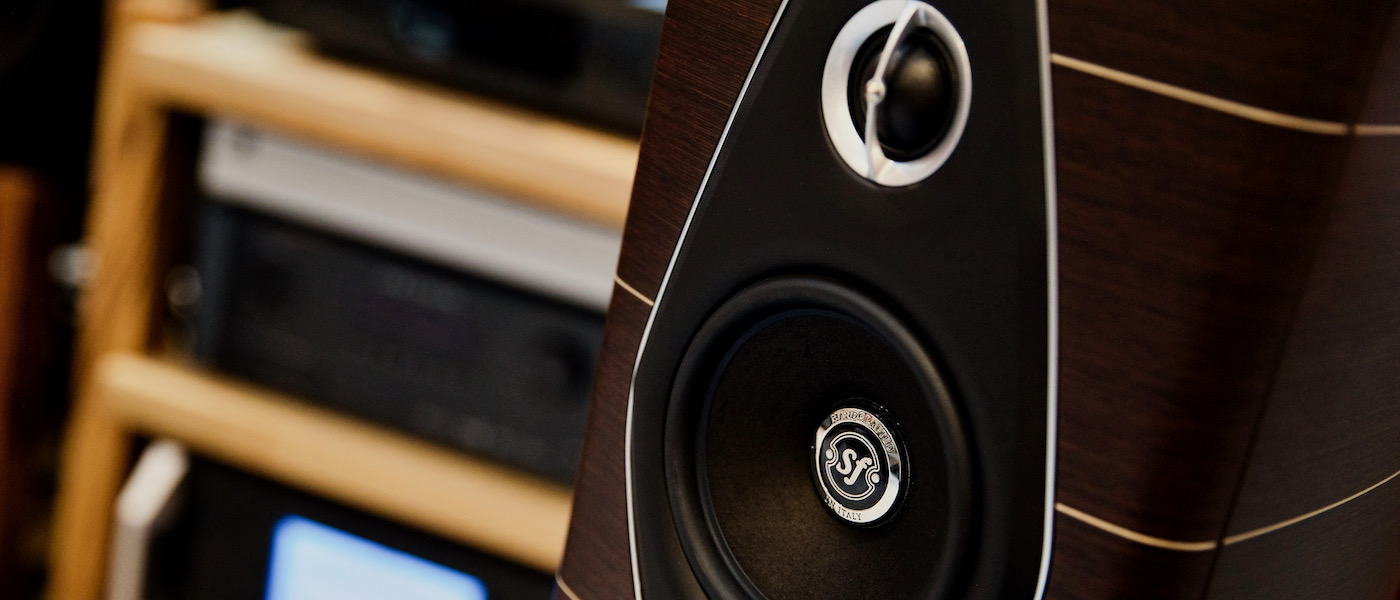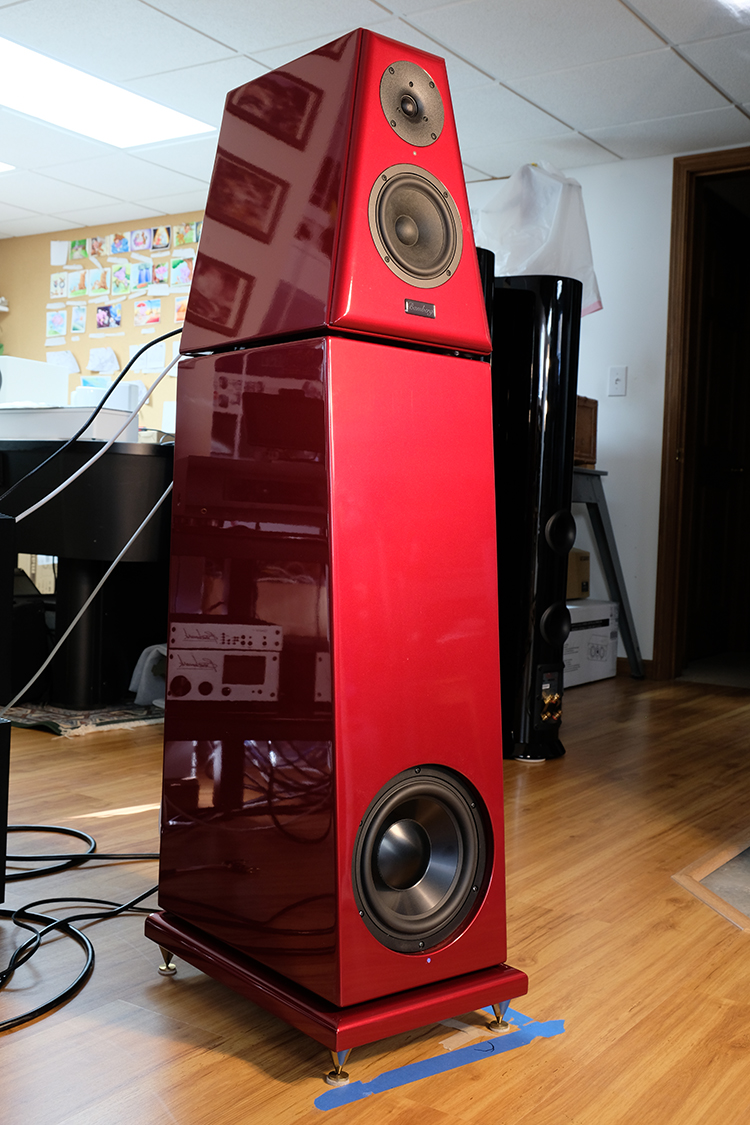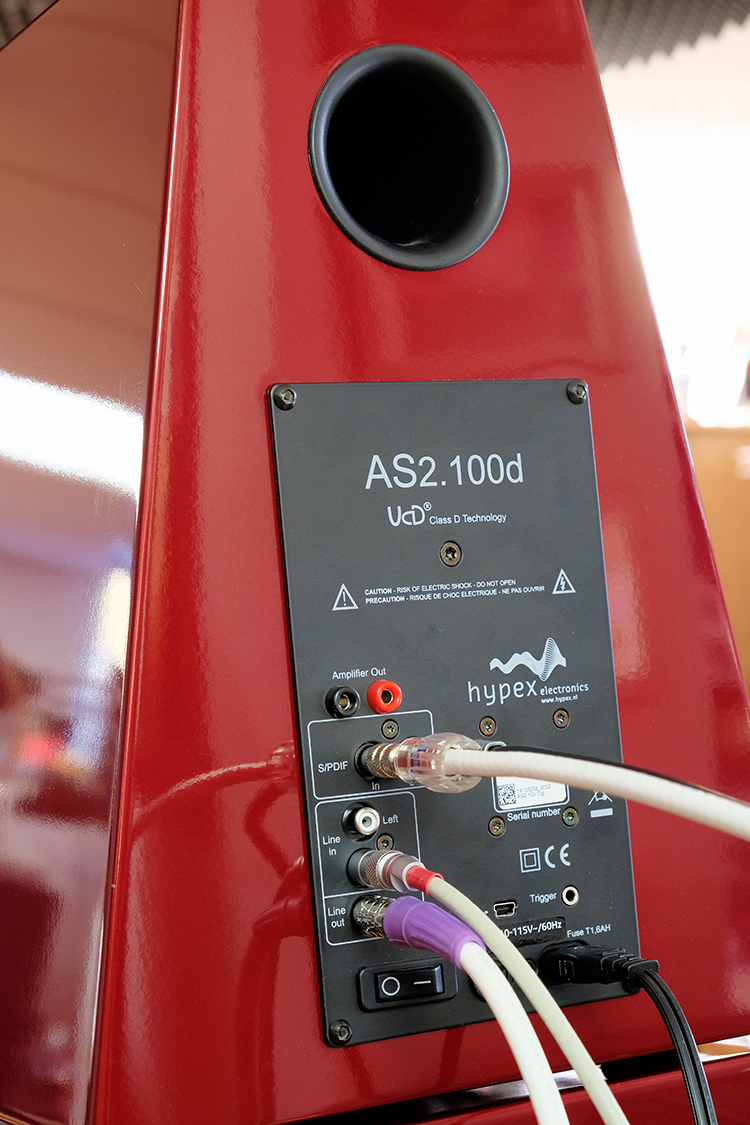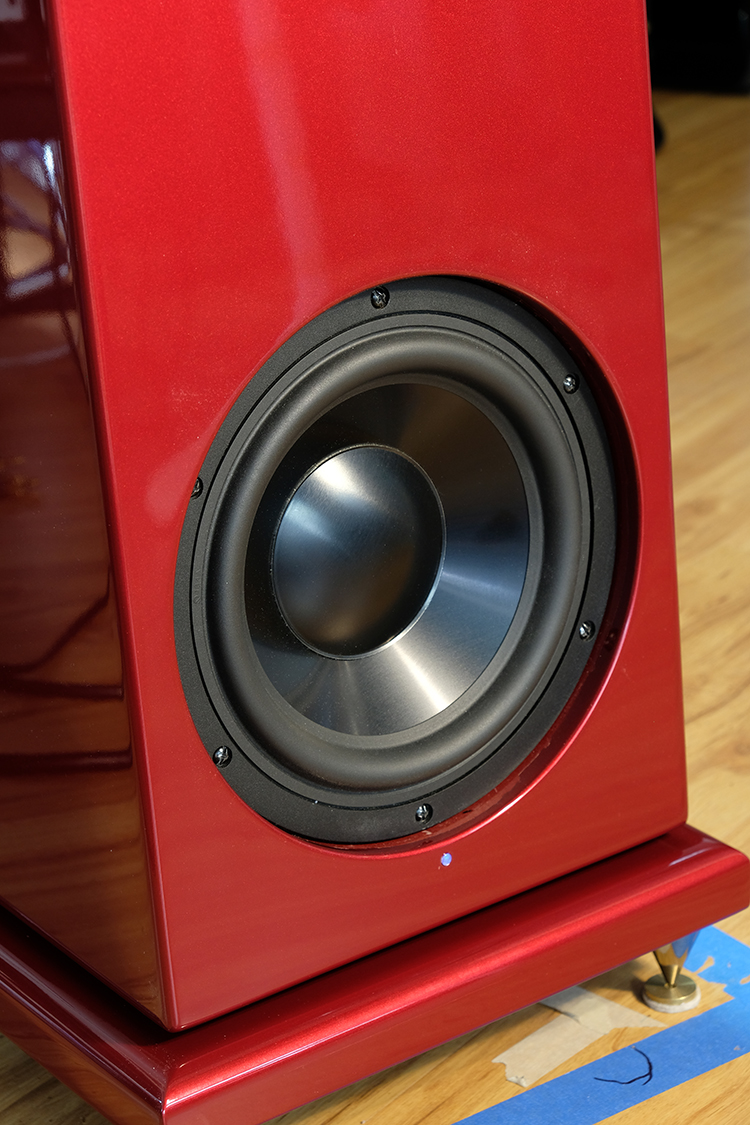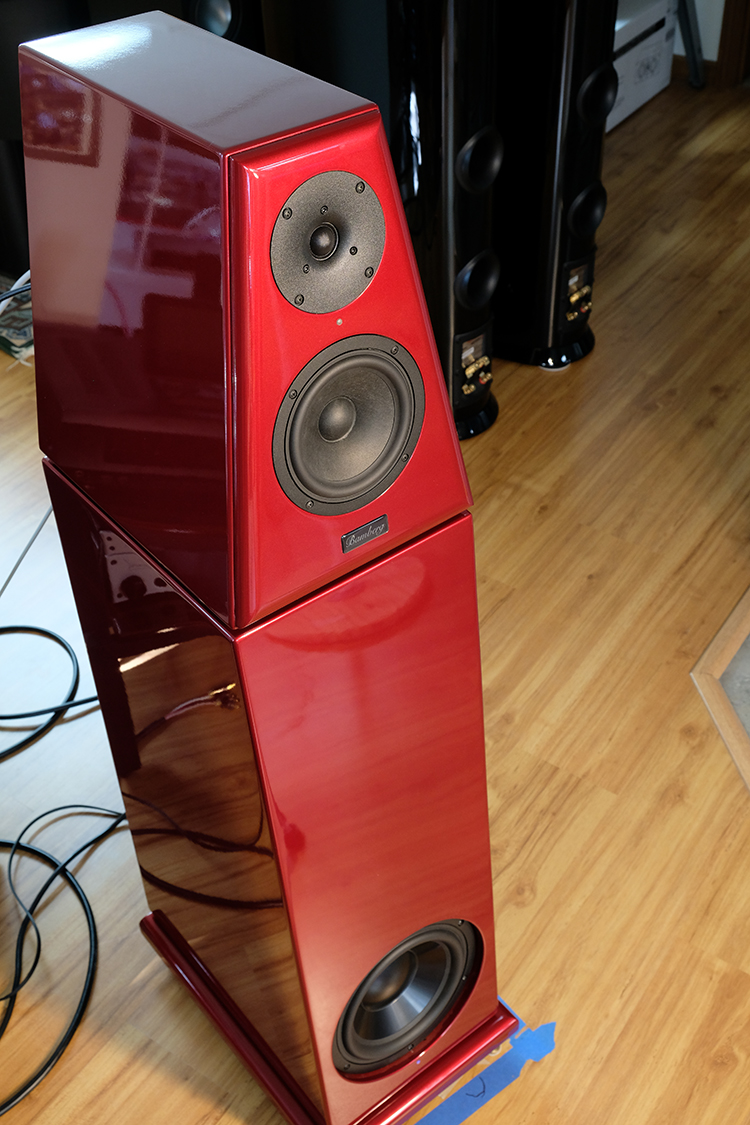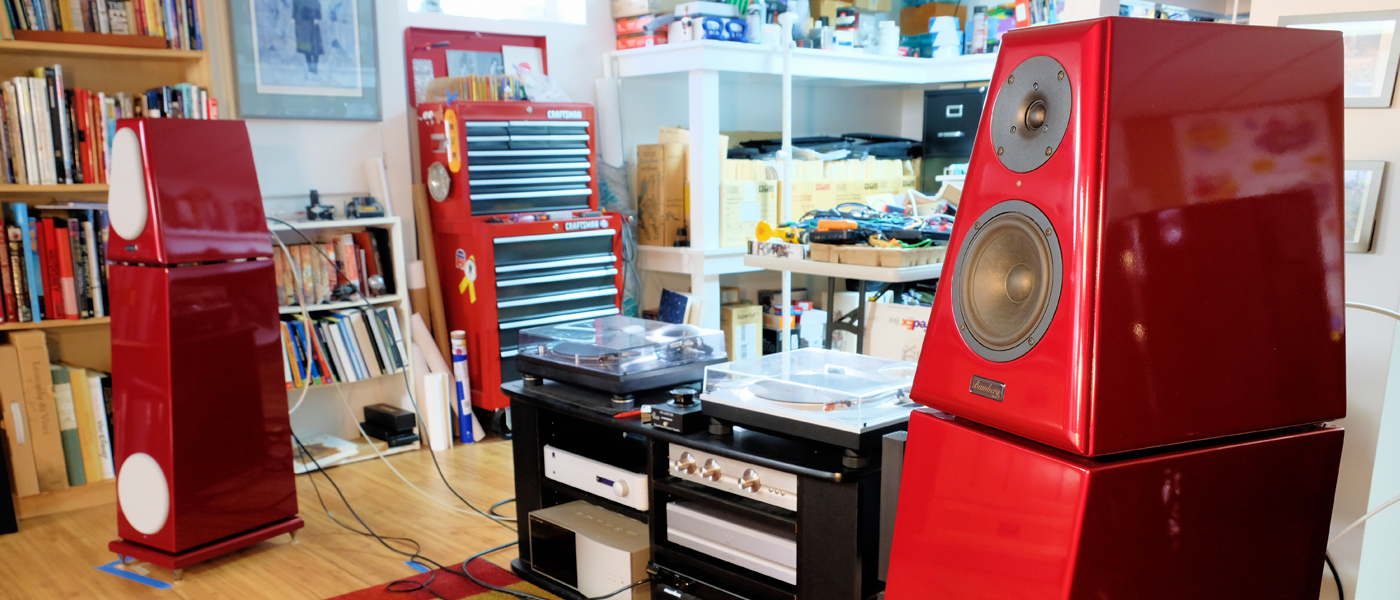
The Bamberg Series 3 TMW is a unique 3-way active floor-standing loudspeaker that has been designed to deliver near full-range reproduction in an almost plug-and-play fashion. The speakers come with their own amplification, onboard DSP, digital and analog inputs, and basic remote control. Add a source and you are off and running.
Bamberg Series 3 TMW Active Loudspeaker
- Deep and spacious sound quality with excellent detail retrieval.
- Bass response extends to the high 20 Hz range.
- Available in a variety of configurations.
- Owner support was particularly good and assistance in tweaking the DSP settings was excellent.
- Wish there were a few more digital inputs.
Full Disclosure, I’ve known the owner and principal designer of Bamberg Audio, Phil Bamberg, for about 12 years now. Around 2007 I was looking to purchase a pair of monitor speakers and while I had a modest budget, I was after something different, something that wasn’t from a larger manufacturer. I had been looking at the well-regarded Ellis 1801 stand-mounted speakers but Dave Ellis at that point was on a speaker-building hiatus and he directed me to Phil’s operation. Once I met and spoke with Phil about his products and his design methodology, I found that I liked his thinking and approach, so I decided to purchase my Series 2 MTM monitors from him which I still own and use regularly. Paired with an external electronic crossover and a pair of capable subwoofers, these speakers were the anchor point for my 2-channel reference system for a good long time.
Phil has continued to design and build loudspeakers to order since then, both for his own company and by contracting his services out to other manufacturers. He has spent time working for Thiel, SVS, Usher, and Klipsch. From my end, I’ve done some logo design work for the Bamberg Audio website a few years back. Until now I have never professionally reviewed any of Phil’s speakers.
Phil contacted me a few months ago and asked if I would be interested in conducting a formal review of an active speaker called the Series 3 TMW. Having been a while since I looked at what he had been up to, I quickly looked it over and said yes. It was a completely different design from my now long discontinued Series 2, and it fits in with the slew of active speakers that I have been reviewing of late. Bamberg Audio is based just outside of the Indianapolis area so Phil took a day to drive the speakers out here to Central Ohio and we set them up in my studio listening space.
Design:
Active 3-Way Bass reflex loudspeaker via dual rear ports.
High-Frequency Driver:
Single 7/8-inch soft dome tweeter with shallow waveguide.
Mid-Range Driver:
Single 6-inch driver with fiberglass/paper cone.
Low-Frequency Driver:
Single 9-inch driver with Aluminum cone.
Frequency Response (Manufacturer):
22Hz (-6dB) – 20 kHz (+/-2.5dB)
Sensitivity:
89 dB SPL (2.83V/1m)
Crossover Frequencies:
Linkwitz-Riley 4th order @ 430 Hz & 2.8 kHz.
Nominal Impedance:
4-Ohms (Passive Monitor Option).
Internal Amplifiers:
Hypex UcD Class-D
Tweeter- 100-Watts (4-Ohms)
Midrange- 100-Watts (4-Ohms)
Woofer- 250-Watts (4-Ohms)
Dimensions (H x W x D):
48” x 12” x 17.5”
Weight:
88.0 lbs. (each)
Available Finishes:
Various wood veneer and custom automotive paint finishes.
Accessories:
Remote control, Carpet spikes.
Warranty:
2 Years (Electronics), 5 Years (Cabinets)
MSRP:
$5,800.00 (pair)
Website:
Company Directory:
SECRETS Tags:
Bamberg, series3tmw, active, loudspeaker, dsp, bamberg series, TMW, Active Loudspeaker, speaker review, review 2021, floor standing speaker
The Bamberg 3 TMW, as tested, was comprised of a 2-way active monitor sitting atop an integrated active bass stand. The individual sections can be purchased separately so one can build the system over time if desired.
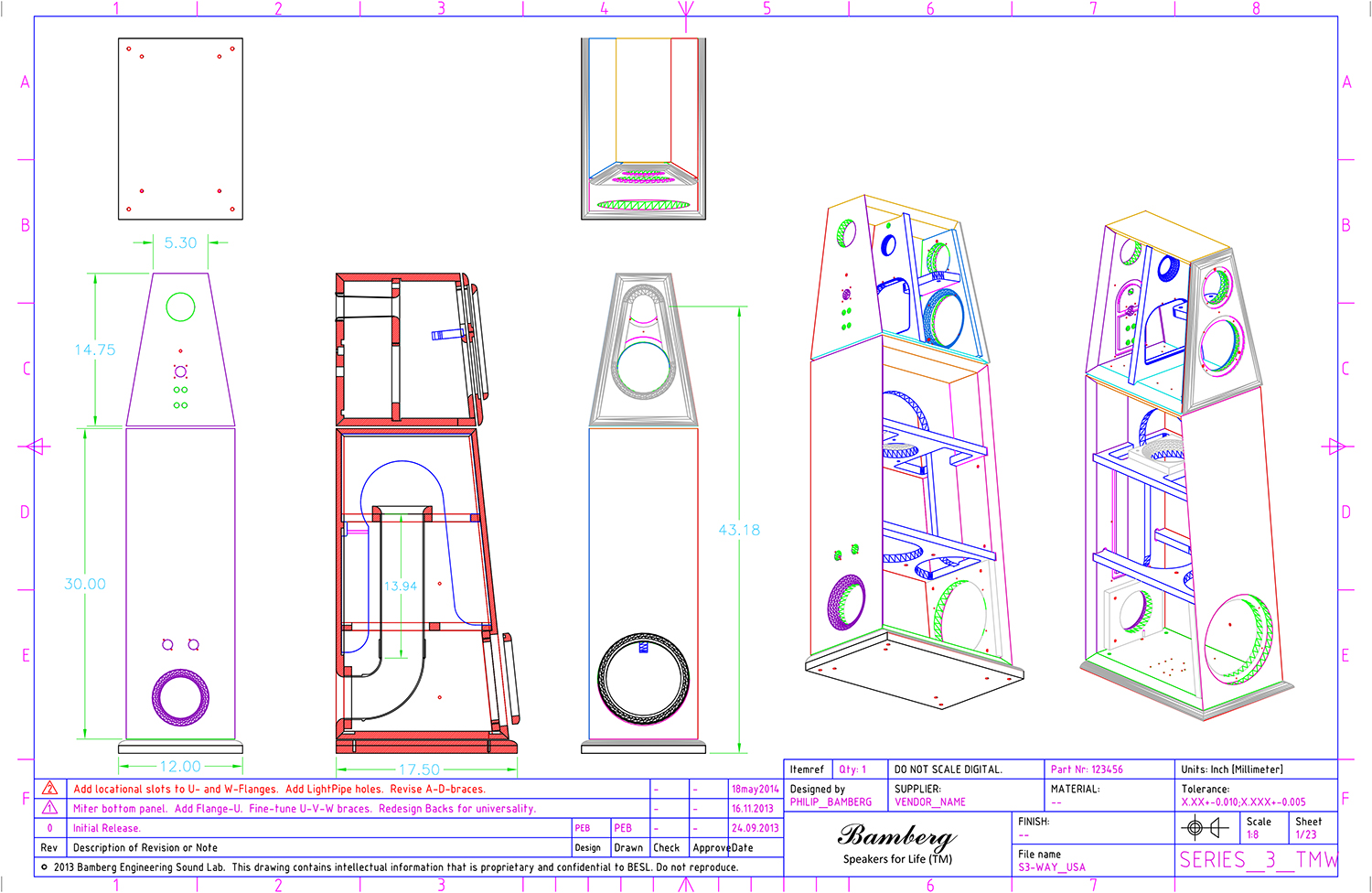
Bamberg Series 3 TMW, blueprint view
The Series 3 TMW is constructed of 3/4-inch MDF all around with a 1-inch front baffle on the monitor and a 1.5-inch-thick baffle on the bass stand along with extensive internal bracing used throughout. All panels are cut by a CNC machine for accuracy and consistency.
The monitor portion consists of a trapezoidal-shaped cabinet housing a 7/8-inch soft dome tweeter nestled above a 6-inch fiberglass/paper coned midrange driver (all the Series 3 TMW drivers are sourced from Wavecor). The back of the cabinet has a 2- inch diameter dual-flared port right behind the tweeter. That port is only active when the monitors are used in a standalone application. As tested here, the 430 Hz crossover to the bass stand essentially bypasses the monitor port altogether. Just below that is the main input/output panel for the electronics and two of each speaker’s three onboard amplifiers. The amplifiers are all Hypex Class D, 100 watts for the tweeter, 100 watts for the midrange driver, and 250 watts for the woofer, that amplifier residing inside the bass enclosure. Inputs and outputs consist of speaker banana-plug binding posts (which we don’t use with this speaker), SPDIF coaxial input and output, left and right analog line inputs, a line output for the woofer, a Mini-USB input to hook up a computer for audio input and programming and a 2-prong power connector plug. The digital input accepts sampling rates up to 192 kHz. Both analog and digital inputs are converted/downsampled to 48 kHz for filtering and processing internally.
The monitor sits on top of the large, ported bass enclosure, separated by 4 large Sorbothane isolation feet. The base section has an angled front baffle that nicely transitions into the same angle as the baffle of the monitor. It sits on a 1.25-inch plinth where the large carpet spikes screw into each corner. The 9-inch cast aluminum woofer is installed towards the bottom of the front baffle. This placement ends up being slightly forward of the midrange and tweeter and is done to help time-align the drivers. The rear of the cabinet has a large 4-inch dual-flared port at the bottom. Just above it is an RCA line input jack for connecting to the monitor and a SpeakOn connection for a grounded power plug.
The speakers come with a small oval Hypex-branded remote control that allows cycling through input selections, volume control, and muting. The small driver grilles for the monitor and base stand magnetically attach to the speakers. The Series 3 TMW are available in a variety of paint, veneer finishes, and grille colors. The review samples were finished in a sleek-looking ruby red automotive paint color with light grey fabric grilles.
Although the speakers have both digital and analog inputs along with a basic volume control, Phil Bamberg likes to suggest purchasing one of MiniDSP’s Dirac enabled products (which he sells) to use as a preamp/control center. He says that for the end-user, Dirac conveniently helps sort out the bass issues in a room without the owner having to mess with the speaker amp’s onboard PEQ or risk altering the digital crossover settings by accident.
At the time of this review, Phil had already sold his last MiniDSP box, so I used the speaker’s “au naturel” with Phil assisting me later by telephone with setting up the onboard PEQ to tame some room issues.

Bamberg Series 3 TMW, room setup
The Bamberg Series 3 TMW were set up in my studio listening space at roughly 9-feet apart and toed-in approximately 20-degrees towards the listening position. My listening seat was 10-feet away from the center point between the speakers.
Secrets Sponsor
Sources used were an ELAC Discovery Music server (as a ROON endpoint) whose coax digital output was hooked directly to the coax digital input of the right (Master) Series 3 TMW speaker. Another SPDIF coax cable then passes the digital signal from the right speaker to left. For vinyl playback, I used my KAB modified Technics SL1200 MK 6, with an Audio-Technica OC9ML/II MC cartridge and a Shure M97xe with a JICO SAS stylus, respectively. The turntable was hooked up to the Pass Labs XP-25 phono preamplifier whose RCA outputs hooked directly to the analog inputs of the speakers. I used the supplied remote control to manage the speaker’s volume and input selection.
Phil Bamberg personally delivered the Series 3 TMW and helped with the initial setup in my studio listening space along with walking me through the various features and general operation. After he was content that the speakers were performing to his satisfaction, we agreed that I would do some initial listening and then take some measurements. The idea being that since I was not using one of the Dirac-enabled MiniDSP products that he recommends using with his speakers for bass correction, he would review my measurements and suggest some PEQ settings for me to dial in directly into the speaker via computer and a USB cable. He would walk me through this step by telephone because it involved using the HypeX amplifier configuration software and he wanted to ensure that I did not inadvertently overwrite any of the speaker’s digital crossover settings while adding PEQ.
My initial thoughts on the Series 3 TMW were that, as a made-to-order set of loudspeakers, they were handsome, very solidly constructed, and finished to a very high standard. While my personal finish preference in speakers runs towards wood veneer, the paint finish on the Bamberg speakers was excellent, smooth, and lustrous. Every surface on both the monitor and the base section felt properly braced and sounded inert when wrapped with my knuckles.
Sonically, the speakers immediately struck me as pleasing. Their imaging was extremely precise while not quite venturing into the hyper-analytical realm that the active RBH PM8 speakers had. Tweeter and midrange integration was particularly good in that, beyond being detailed, the imaging and soundstage extended very deeply and quite wide. It made listening to complex classical pieces a real treat as I could easily picture where instrument sections and individual soloists were in the soundscape. Vocal performances sounded excellent with plenty of body and detail to both male and female voices. Female voices occasionally sounded a little more forward, depending on the song, but not so much that I found it too much of an issue. Singers just came across with lots of dimension and imaged extremely well.
Having a direct digital connection to the speaker was a new experience for me but it worked very well in practice. ROON had been set up to cap all the high-resolution digital content to 192 kHz and the Bamberg speakers seemed quite happy working with that. Connection quality was robust and consistently dependable. The little Hypex remote control unit for the speakers isn’t overly memorable, being an inexpensive plastic orb, but it’s comfortable in hand and it does the job of controlling volume and switching sources without complaint. The speakers were programmed to default to the digital input but will switch to analog at the push of a button on the remote. They will also switch automatically by sensing when the digital input source is absent, but an analog source is present.
Speaking of analog, my turntable sounded especially good through the Series 3 TMW. The incoming analog signal, subsequently converted to digital by the speakers for processing, showed no sign of imparting any harshness or etch to my vinyl listening sessions. LPs sounded delightfully smooth and liquid through these speakers, yet the music also had a vibrancy to it that over and over made me play much more vinyl than I was otherwise intending.
The bass reach of the Series 3 TMW was also quite impressive, reaching down into the higher 20 Hz region. There was certainly significant impact and presence to be felt when listening to organ music and electronic music causing some lower notes to be easily felt as well as heard. On some hard rock and R&B, I did end up feeling like I was missing a little bit of drive in the upper bass region where the power and guts of that music reside. Spinning up AC/DC’s Highway to Hell and Billy Gibbons’ Big Bad Blues album confirmed the feeling that this would be an area to work on with Phil once I got some in-room measurements done to share with him.
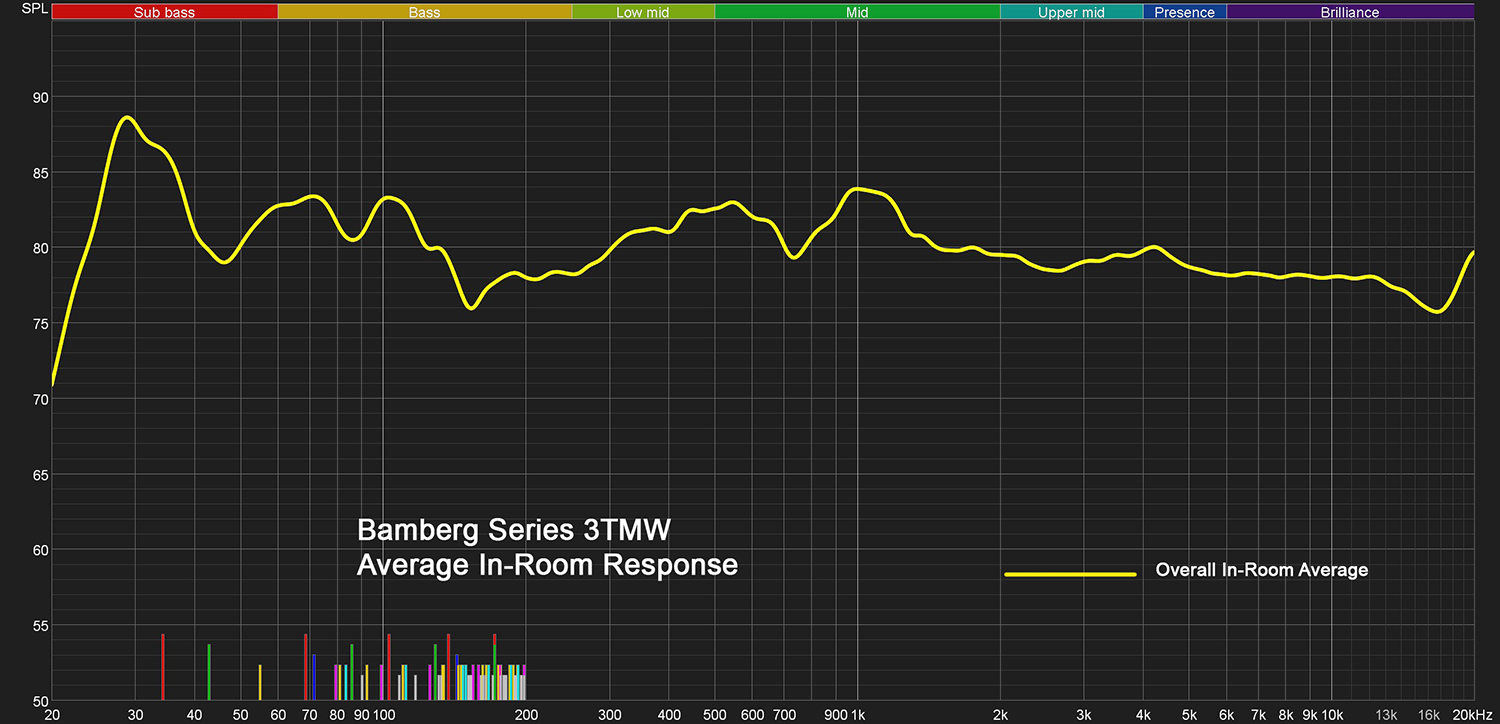
Bamberg Series 3 TMW, average in-room response-standard
After taking an initial round of in-room average response measurements of the Series 3 MTM, I sent them off to Phil and, after a phone call where we discussed what I was and wasn’t hearing with the speakers, he came up with a set of 4 PEQ (Parametric EQ) filters, each consisting of Frequency, Q (width) and Gain level that I would need to program into each of the speaker’s plate amps. So, I downloaded the Hypex amplifier software onto my Microsoft Surface tablet, hooked it up to the first speakers via USB cable, and launched the program. The software recognized the speaker and allowed me to enter the filter editing section. The first thing I did was make a backup copy of the existing speaker settings. An extra piece of security should I seriously botch this little exercise. Phil then carefully walked me through programming each of the PEQ filters so that I didn’t inadvertently step on any of his existing crossover settings. After completing and saving the settings for each speaker I took a new set of in-room average measurements.
David Rich Notes: This is a significantly better way to design an active speaker in that each speaker’s plate amp had provisions for multiple PEQ adjustments and by Carlo taking measurements, and reviewing them with the designer, a targeted number of filters were created and successfully implemented, as you will see below. Ideally, a large manufacturer might include a fully automated method to do this, built into each speaker, and all an owner needs to do is attach a microphone to the speaker and press a button. As a small, independent manufacturer, Bamberg Audio recommends using an optional Dirac-enabled MiniDSP SHD (or SHD Studio) box to perform the same task. The box is connected to the speakers via a digital SPDIF connection keeping all processing in the digital domain until the final D to A conversion inside the speaker. With these speakers, my preference would be dialing the PEQ values directly into the speaker, as was done in the review, and keep things simple, but for those looking for a more automated solution, the SHD box is available as an alternative.

Bamberg Series 3 TMW, average in-room response-with PEQ
Much better. Phil’s suggestions not only restored some of the missing upper-bass energy but had smoothed out a bit of a peak at 1kHz. The big bass peak at 30Hz (that was being excited by the left speaker being closer to a wall) was tamed by a suggestion Phil gave me of plugging the left speaker’s bass port with some foam.

Bamberg Series 3 TMW, average in-room response-with PEQ, and plug
That little hack brought it down just enough. As it stood, though, the 4 PEQ filters made a substantive improvement in my enjoyment of the Series 3 TMW. The bass response now sounded complete and powerful but not boomy at all. With the right music, the room became solidly pressurized, and rock and blues now had all the rhythm, power, and drive that was a little lacking before. This is how I listened to the system for the remainder of my review period.
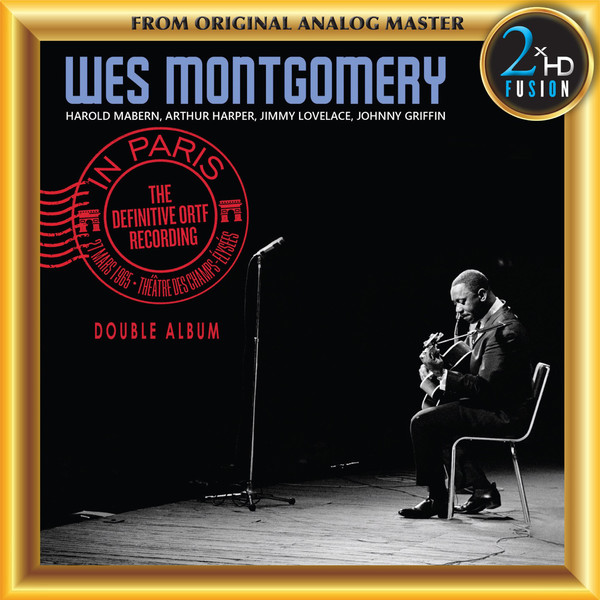
Wes Montgomery in Paris- The Definitive ORTF Recording
Wes Montgomery in Paris, The Definitive ORTF Recording. 24/96 via HDTracks.
A favorite and superb-sounding live recording. I have not heard it better in this room. The sense of space and dimension is profound. There is a lovely sense of power in the lower-mid and upper bass region that adds a sense of drive and, for lack of a better word, “boogie” to this live performance. The piano solos particularly benefit from this. They have added meat to their sound. Everything about Wes’s guitar playing is detailed and lifelike.
His playing is fluid and smooth as is his trademark, but the speakers reproduce the added zing to the strings that this recording captured so effectively. The cymbals are clean and metallic sounding without getting too hot. The treble reproduction of the Series 3 TMW is right where I like it, balanced, crisp yet not fatiguing.

Isao Suzuki Quartet, Blow Up
Isao Suzuki Quartet, Blow Up, Three Blind Mice, DSD64 files.
Originally recorded in 1973, Cellist Isao Suzuki plays with an avant-garde ferocity, from the opening track “Aqua Marine” the Bamberg Series 3 TMW can palpably render the depth and weight of those deep cello notes with total conviction. I could easily hear all the details coming from the cello strings as the bow was passing over them. The cymbals in the background were also reproduced crisply and with the right metallic sheen.
Drum hits had a great impact to their sound and the results easily were felt as well as heard. The Bamberg’s projected a big and enveloping image with this track placing me squarely among the players. “Everything Happens to Me” is an up-tempo jazz jam. This time the acoustic bass is plucked instead of bowed and the Series 3 TMW let me hear and feel each string pluck with authority. The accompanying piano had great sparkle and decay to the notes that were played. Again, cymbals and drums were rendered superbly. These speakers really made me feel that I was in an intimate little jazz club listening in on the house band.

Diana Krall, Turn Up the Quiet
Diana Krall, Turn Up the Quiet, Verve, 26/96 FLAC via Qobuz
Ah the bane of the audio show demo, she that is the siren, Krall! Well, she makes it exceedingly hard for jazz-loving audiophiles to go “Krall-cold-turkey” since she is regularly producing plenty of demo-worthy material. “No Moon at All” isn’t one I’ve heard in any show demos that I’ve been to, but it probably should be. It is simply an outstanding recording and the performance is sublime. Diana Krall’s voice floats perfectly between the speakers and every subtle nuance, every inflection is laid bare and rendered with such detail and dimension.
These speakers love the human voice, and this track shows that off in spades. Like the Isao Suzuki album, this track has both a bowed cello in the introduction and plucked acoustic bass through the rest of the song. The Series 3 TMW gets the weight and the detail of those bass notes just right for my tastes, well-defined and pitch perfect. The size and depth of the soundstage here are also noteworthy as the speakers don’t just seem to be playing music more than they are putting you in an environment.
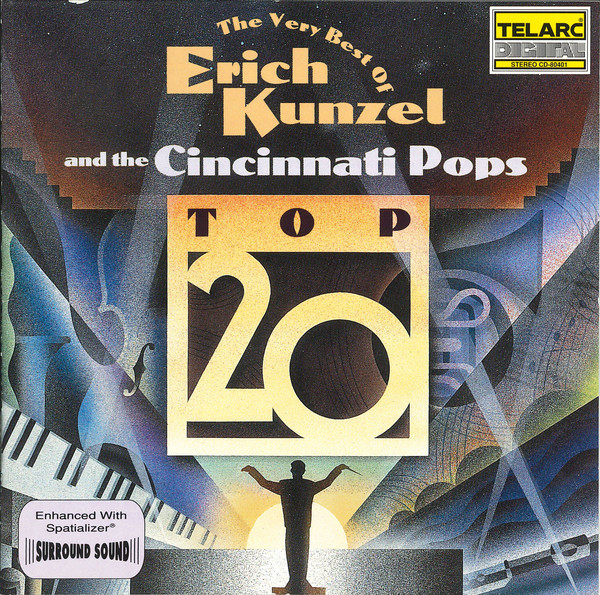
The Very Best of Erich Kunzel: Top 20
Erich Kunzel and The Cincinnati Pops, The Very Best of Erich Kunzel: Top 20, Telarc, 16/44.1k, CD.
There are some things that you always find yourself coming back to. Comfortable jeans and favorite foods are like that and, for me, so is a good Telarc recording. “The Very Best of Erich Kunzel: Top 20” has a lot of favorite orchestral pieces from stage and screen on it and it makes for great music and speaker testing material. “Also Sprach Zarathustra/Star Trek The Motion Picture Theme” starts with that rumbling firmament of bass that the Bamberg speakers allow you to feel through your legs as it slowly builds and presses against your gut by the time the rest of the orchestra climaxes.
Some speakers can get shrill and a little brittle sounding as the horns reach their peak in the piece, but not here. The Series 3 TMW kept the horns sounding bright and powerful but never veering into being shrill. The big multiple bass drum hits when we transition to the Star Trek theme packed a tight and solid wallop. The Cincinnati Pops orchestra sounded wide and expansive as they dove into the familiar music. The same goes for the track “Sing, Sing, Sing,” with its opening avalanche of bass drum rhythms. At volume, I felt each one of those drum impacts without them sounding bloated or mushy. Eddie Daniels on clarinet sounded smooth and fluid during his solo, with that noticeable “woody” resonance to the instrument, imaged perfectly in the center of the stage. A favorite of mine on this compilation is John Barry’s theme to “From Russia With Love” and the Series 3 TMW rendered it with depth and scope. In doing so, however, the speakers didn’t obscure the subtle details like the clean ring and sparkle of the triangle in the background or the metallic chattering of the tambourine cymbals. It all sounded quite fantastic.
Were there some things that I didn’t like about the Bamberg Series 3 TMW? Well, I wish they would have had more than one SPDIF digital input. Turning off the speakers to switch digital sources by hand was slightly annoying. Balanced XLR inputs would have also been nice to have as well, while we’re on the subject. While maybe a bit of a tall order for a small manufacturer to do, some sort of volume indicator, like a strip of micro-LEDs on the front face of the master speaker, like what Dali does on its active speakers would have been appreciated. Not knowing where the volume is at when you first fire the speakers up can be a little startling when you play that first track. Also, a way to show what input is active at any given moment would be helpful too. Keep in mind however that if one purchases these speakers with a MiniDSP SHD or SHD Studio box (as Phil recommends) for example, all the above nitpicks are rendered moot.
Sound quality-wise, on a couple of live concert recordings, I found that I could localize the bass as coming from the bottom of the speaker. On everything else I listened to though, both live and studio recordings, the bass was always nicely integrated. It was an odd occurrence and something that happened in only two live recordings.
Functional quirks aside, there’s no question that, from a sound and build quality perspective, the Bamberg Series 3 TMW provides a hell of a lot of performance for the money.
Measurements by Carlo Lo Raso, Technical Analysis by Carlo Lo Raso and David A. Rich.
Bench tests were performed with a Cross Spectrum Labs calibrated UMIK-1 USB microphone connected to my Surface 3 PRO tablet and using Room EQ Wizard acoustic measurement software. On and off-axis nearfield measurements were taken with the mic at 1-meter from the center point of the tweeter. Unlike measurements taken outdoors or in an anechoic chamber that measure a speaker in isolation (and assess straight-line engineering), in-room measurements give a sense of how a speaker behaves in the actual environment that it’s used. Both types of measurements are valuable, I just find in-room measurements interesting as they help shed light on what I am hearing and why. That and I don’t own an anechoic chamber!
For these measurements (except for the first one below) the speaker’s DSP was returned to its stock factory settings. Any additional PEQ that I had dialed in for my listening sessions had been disabled.
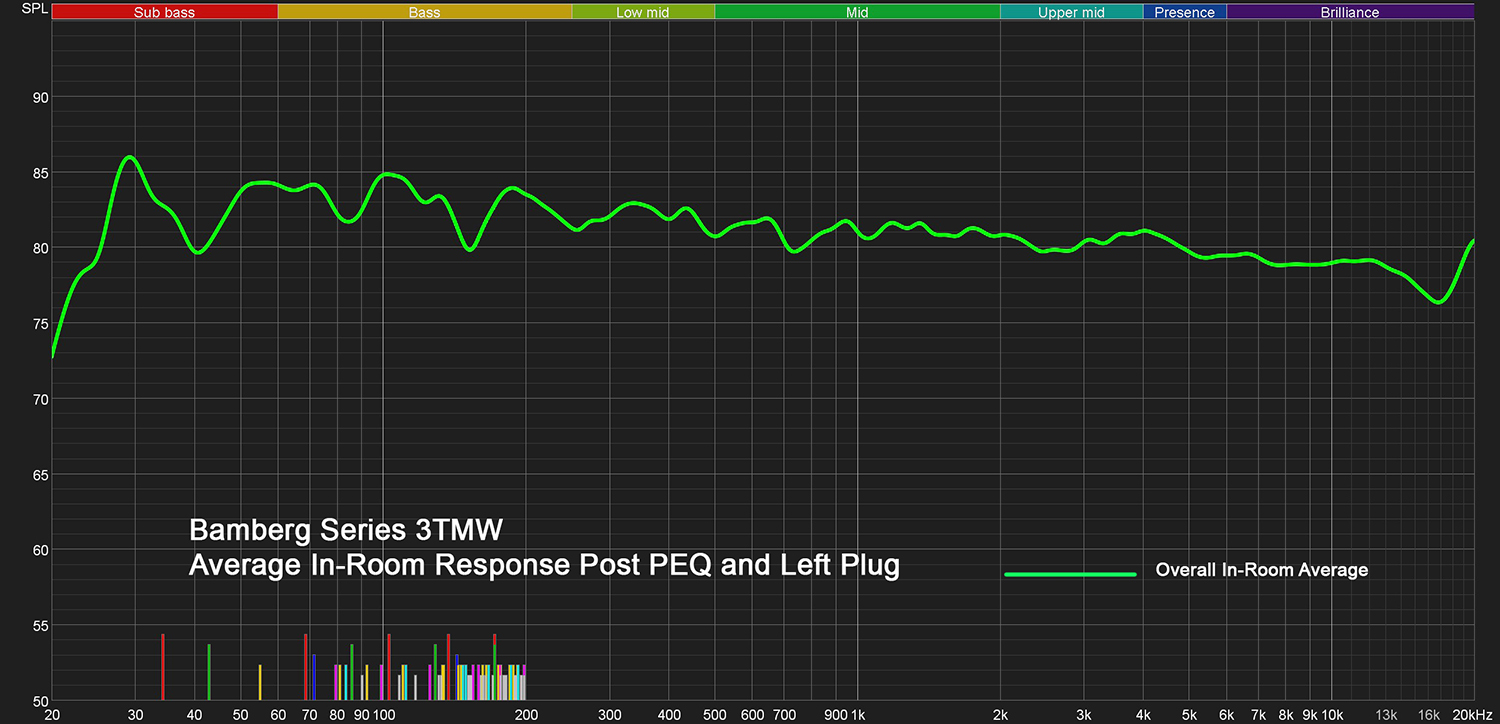
Bamberg Series 3 TMW, average in-room response-with PEQ, and plug
This in-room measurement of the Bamberg Series 3 TMW is an 18-point spatial average. A 9-point measurement was made for the right speaker and then repeated for the left speaker. Averaging both speakers is an approach that others have been using and publishing. Using data from both speakers reduces the modal response of the room by averaging the differences in the response of the two speakers from room asymmetries. The technique cannot eliminate them however and, as such, the response below 300 Hz remains room dominated. This measured response uses the custom PEQ settings that were created for my room. The results show a fairly uniform and gradually declining response across the bandwidth. There is a 5 dB dip at 40 Hz and a 3 dB dip at 160 Hz (possibly a room null). Beyond this, the treble begins to noticeably roll off after 13 kHz until 17 kHz where it starts to snap back up. Bass response rolls off sharply below 28 Hz.
David Rich Notes: With the PEQ adjustments the response looks very much like the HARMAN target curve which is a good first sign of an appealing sounding result.
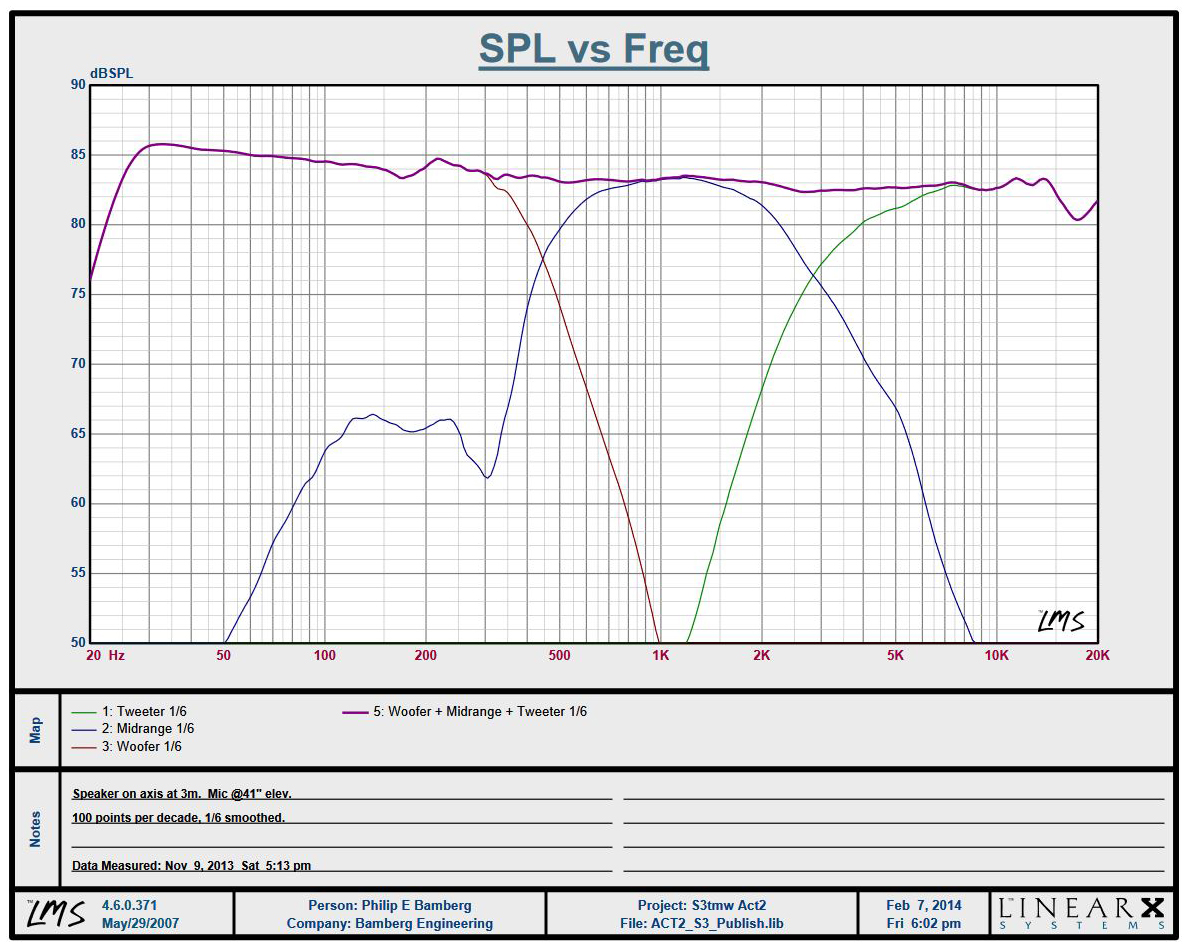
Bamberg Series 3 TMW, manufacturer’s response
This is the measured response (LMS) of the Series 3 TMW provided by the manufacturer. The in-room averaging method used in our first measurement to help reduce room influence, along with the custom PEQ filters puts us in a reasonable vicinity to the manufacturer’s response.
David Rich Notes: Note the 3-meter mic placement (10 feet) which mimics Carlo’s approximate listening distance. This should likely be considered the minimum listening distance from these speakers to allow the driver’s output to converge properly. I am curious about the designer’s choice of the “high-ish” 430 Hz crossover point between the woofer and midrange. I would have expected it to be lower, but it may have something to do with the placement of the woofer driver being closer to the floor.
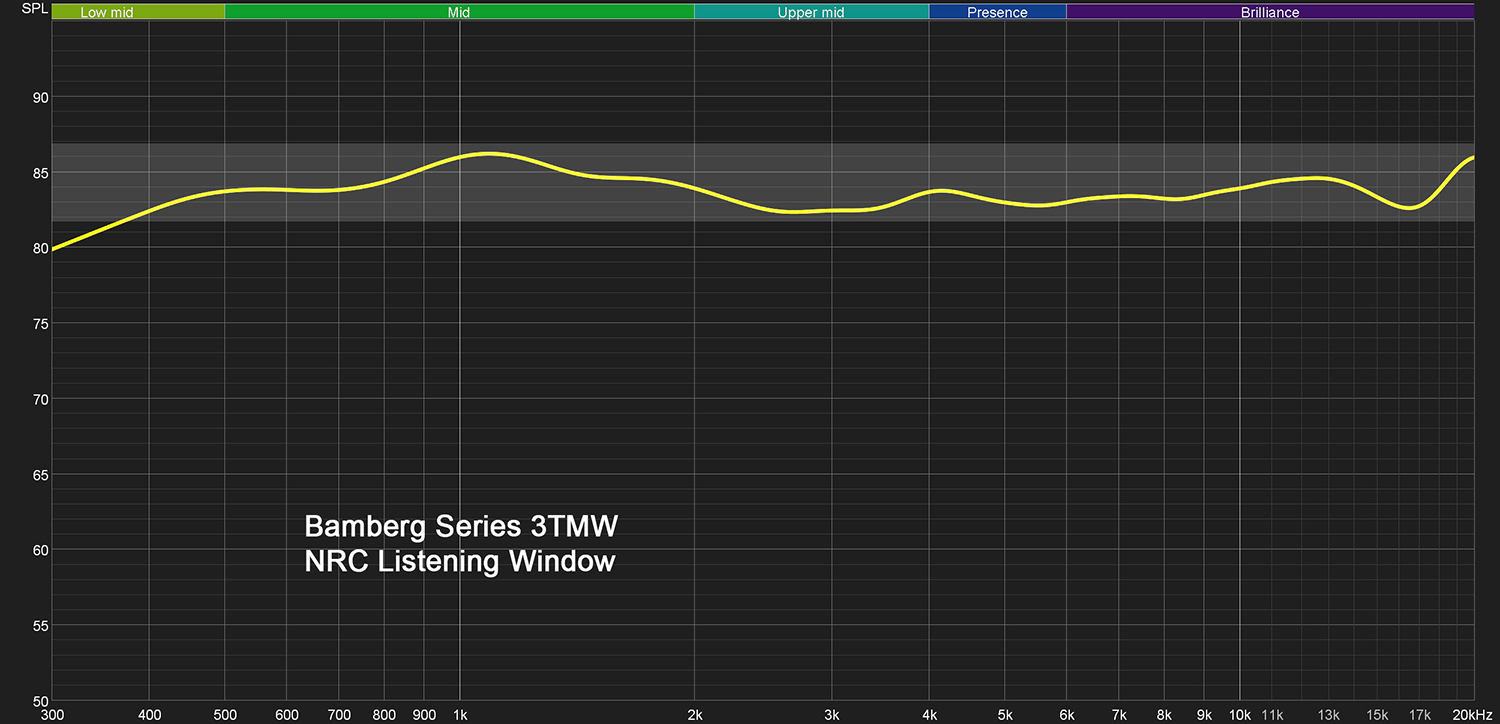
Bamberg Series 3 TMW, NRC Listening Window Response
This is a plot of the NRC listening window for the Series 3 TMW, displayed from 300 Hz on up, which is averaged from the following measurements: 0-degree on-axis, +-15 vertical, and +-15 horizontal. In this portion of the frequency range that is dominated by the speaker (response below 300 Hz tends to be dominated by the room and can vary greatly), we see a small 1kHz bump, but otherwise a very uniform response.

Bamberg Series 3 TMW, Horizontals 0-30 Degrees
Above are the horizontal radiation curves of the Bamberg Series 3 TMW from 0 to 30 degrees, displayed from 500 Hz on up. Looking at the angles most closely related to the direct response, we see smooth curves with no obvious resonances at the 1/6 octave smoothing used here.

Bamberg Series 3 TMW, Horizontals 45-90 Degrees
Above are the horizontal radiation curves from 45 to 90 degrees, displayed from 500 Hz on up. Again, we continue to see generally smooth response curves with no obvious resonances and the expected rate of extended off-axis decline.
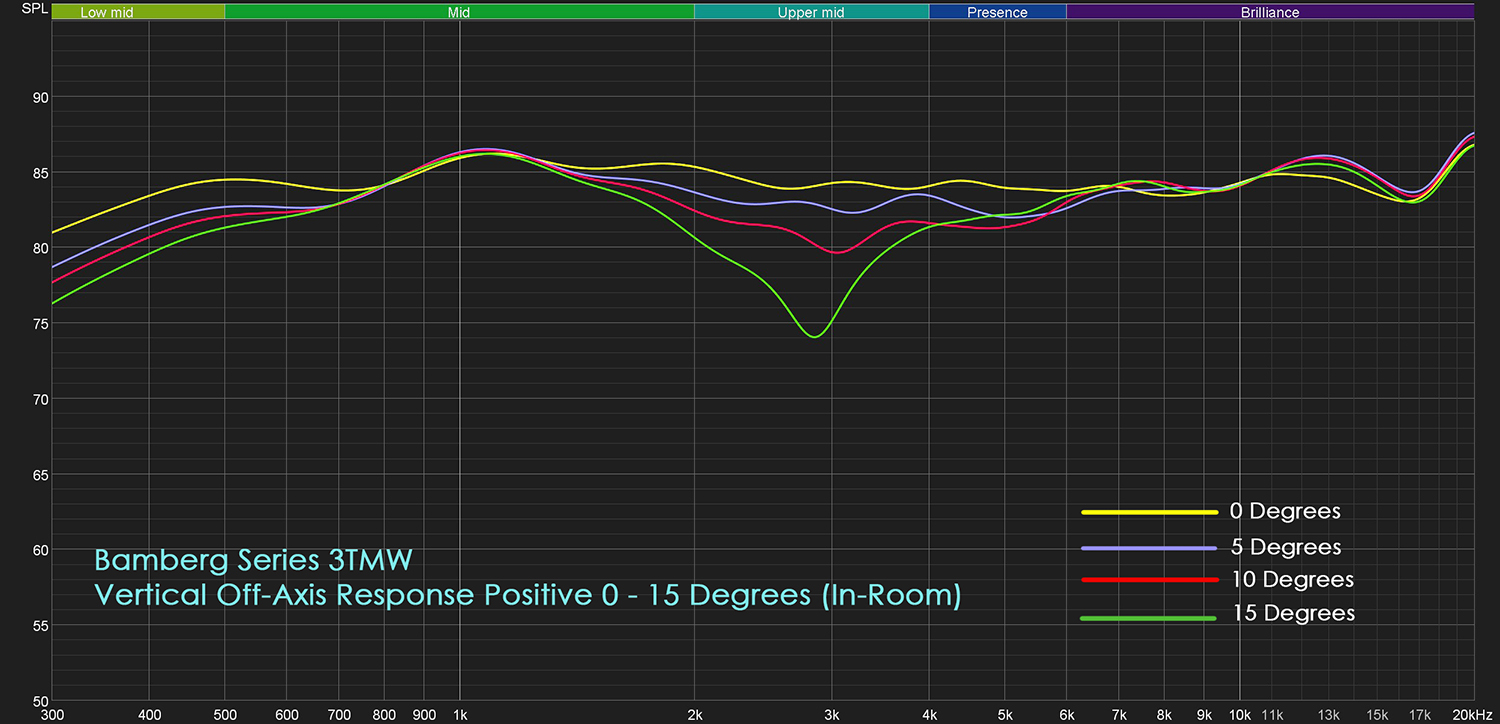
Bamberg Series 3 TMW, Verticals Positive 0-15 Degrees
Moving to the vertical radiation pattern for positive angles for the Bamberg Series 3 TMW, we see the plots for 0 to +15 degrees, displayed from 300 Hz on up.
David Rich Notes: The curves look good to 10 degrees then develop a little more of a dip than typical for a DSP speaker with non-coincident drivers.
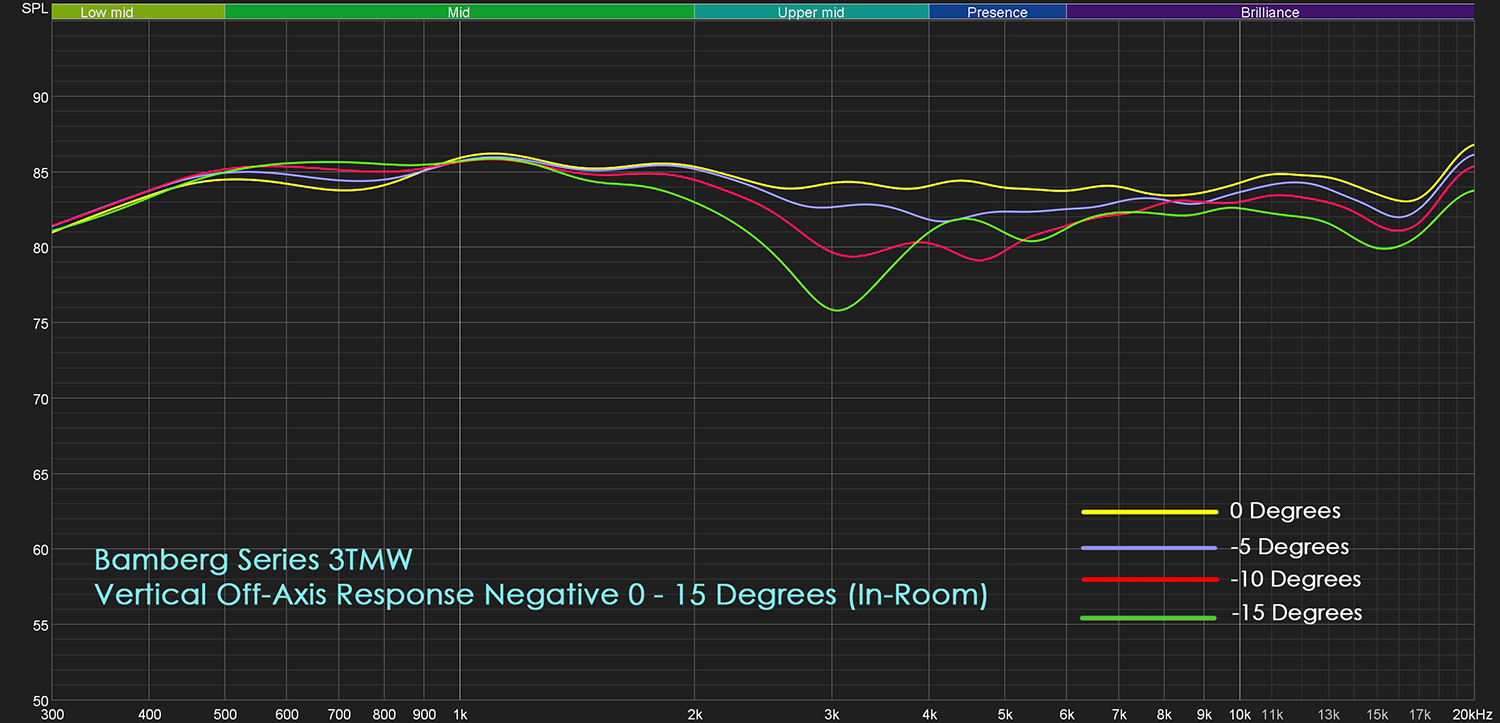
Bamberg Series 3 TMW, Verticals Negative 0-15 Degrees
In the vertical radiation pattern for negative angles for the Bamberg Series 3 TMW, we see the plots for 0 to -15 degrees, displayed from 300 Hz on up. The curves look to be well controlled which improves reflections from the floor to the listener.
The Bamberg Series 3 TMW active loudspeakers show that independent speaker design is alive and well. They are flexible, adaptable, and sound positively superb.
- Superb full-range sound quality, especially after PEQ settings.
- Fantastic detail and imaging.
- Excellent build quality and finish.
- Active. All you need is a source.
- After purchase support is excellent.
- Additional digital and balanced inputs.
- Some way for the speakers to visually display volume and input.
When it comes to speakers, there are a ton of choices out there and a surprising number of them are outside the purview of the big established manufacturers. I like seeing small, independent audio companies add their expertise and perspectives to the products we have available to choose from. In that spirit, it’s quite clear that the Bamberg Series 3 TMW was designed and developed by someone who has a love for both music and engineering. It has been designed to be available in a variety of configurations from a passive monitor to an active full-range system. In that active full-range configuration, the 3 TMW can provide a superb and complete level of performance that ranges from the delicate and nuanced to the positively beastly when called upon. Through my listening I find the Bamberg Series 3 TMW to be superior to several conventional loudspeakers that I’ve heard over the years at over twice their asking price.
While not exactly a simple plug-and-play affair, they do provide you with everything you need to effectively bend your room to their will. All you need to do is provide the source(s). The owner, Phil Bamberg actively supports his customers to make sure that they can make the most of their purchase. I personally have experienced this with Phil long before I became a professional reviewer. If you want a pair of almost no-holds-barred speakers and are open to options that extend beyond the established brands, I suggest you seriously have a chat with Phil Bamberg about these speakers. Think about it, how often do you get a chance to call up and pick the brains of the actual speaker designer? Highly, highly recommended!
The author would like to thank David A. Rich for his valuable assistance.
Thank you for a thorough review, Carlo.
With the Bamberg 3, I have tried to develop a speaker that punches above its weight – it covers 30Hz to 16kHz exceedingly well, delivers a rich and powerful tonal balance, provides imaging that gets out of the way of the music, plays loud enough without strain, and does all this within a compact size.
Secrets Sponsor
Here is some further explanation of some of the design choices I made while developing this 3-way active speaker.
The purpose of the slightly high midrange/tweeter elevation is to raise the sound stage, which also gives the listener a “lift” subjectively. You feel more like you are at the live event.
Localization in the horizontal direction from the low woofer elevation is mitigated because the woofers are stereo (rather than a single subwoofer, which must be crossed low). For the vertical plane, the listener’s attention is always drawn to the higher frequency source. The overtones from an upright acoustic bass can be heard through the tweeter after turning off the woofer and midrange – you can even follow the bass player in the song!
The Reference Axis (aka Design Axis) actually emanates from an elevation halfway between the midrange and tweeter, and projects outward towards the listener 3-meters back and whose ears are at 36” elevation. Time delays for the woofer, midrange, and tweeter are adjusted to account for that particular point in space. But this method also assures that the sound integrates properly for the most common listener distances from about 7 to 10 feet, and ear heights of 30-48”. Too many speakers are designed at 2 (or even 1) meter distance, and on the tweeter axis. In my experience, such a short measure distance will cause the time and phase relationships between the drivers to degrade when re-measured at typical listening positions.
I use a variation of the NRC window during the raw SPL driver responses in that I also include the +/-30° pair of horizontal curves. In other words, the single curve used for filter design is the average of on-reference-axis, +/-15° and +/-30° horizontal curves, and +/-15° vertical curves. This ensures that any baffle edge diffraction effects also “get a vote”. Incidentally, the 10° sloping sides of the monitor help to spread out the edge diffraction as well as push them up higher in frequency.
I call the octave from 2-4kHz the “annoyance band”. Fletcher-Munson curves show that this range always sounds louder to us. This can be verified by playing test tones – they truly sound louder here. By choosing appropriate midrange and tweeter diameters, and then setting their cross point in the center of this octave (3kHz), I can achieve the Grundy voicing in a subtle way. We know that the vertical curves will show off-axis dips at the cross point. Effectively my speaker measures flat on-axis, but its power (room) response will subdue this trouble region slightly. (By the way, by lowering the mic to halfway between the midrange and tweeter centers, Carlo would have measured a more symmetrical variation in the positive and negative vertical curves.)
If there is one room boundary that can be counted on to always be at the same relative position to any speaker, it is the floor. We call the reflection from the floor that occurs about halfway between the speaker and listener “the floor bounce”. Since it is delayed in time from the direct sound, it causes a comb-filter effect. The fundamental (starting) frequency varies depending on speaker driver height, ear height, and listener distance. The closer to the speaker, the lower in frequency is the floor bounce fundamental. When we measure a 41”-high midrange driver at 1-meter, we see a cancelation at 160Hz. At 2-meters, the dip moves up to 230Hz. At 3-meters, it occurs at 300Hz, as shown in Figure 20 above (blue curve for the midrange driver). In the raw response (i.e. before crossover filters) the midrange showed a 15dB deep dip one octave wide! There is also a floor bounce from the woofer itself, but since the woofer is so close to the floor, it occurs above 1kHz.
By setting the lower cross point at 430Hz, the woofer is at full reference amplitude there, and the midrange is getting pretty quiet at the problem 300Hz. Voila – the floor bounce has been mitigated!
Allowing the woofer to cover a wider band also delivers a more impactful bass sound. The single driver reproduces drums and bass guitar with more punch. There are no low cross point phase rotation effects to both the woofer and midrange anywhere in the bass band. Nor is the midrange affected by the dominant room modes which occur below 300Hz.
The sum effect of a flat response from 25Hz to 800Hz is simply a richer and more powerful sound, and coming from a rather compact speaker!
I really think that having room correction performed separately is the way to go. We are simply correcting the ill room effects for the speaker in its location and for the listener’s location. The processing is more complex than simple parametric EQ filters, and it is performed at full-scale digital resolution. With the miniDSP Studio, we also get customizable user “house” curves, four user save presets, tablet/PC/phone remote control, additional digital inputs internet radio, and music streaming. And of course, the front panel displays volume, input, preset#, and room correction status. It’s a great “mandatory option” for just a little more investment.
Thanks again for a terrific review that captures the essence of this unique speaker.
Philip E. Bamberg
Bamberg Audio


